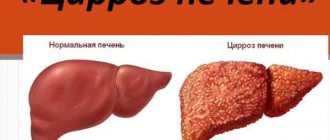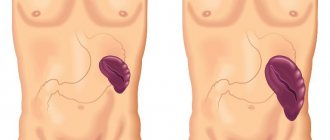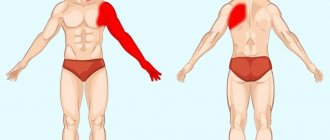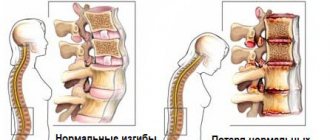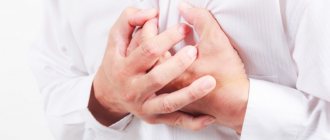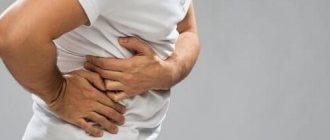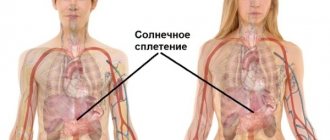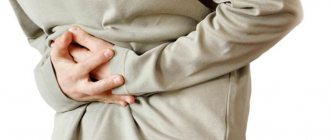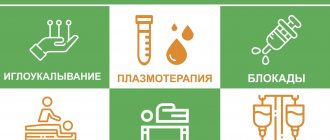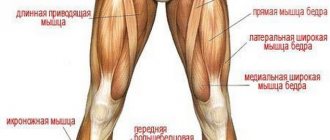Pain and burning under the ribs on both sides are common symptoms that indicate diseases of the liver, pancreas, gallbladder and biliary tract.
Often these signs are the main ones, since they prevail in severity. There are additional symptoms in the form of bloating, nausea, vomiting, bitterness in the mouth, loss of appetite, weakness, depression and emotional instability.
If the right and left sides hurt at the same time, a comprehensive diagnosis is required, since many diseases of the hepatobiliary system manifest themselves in this way. Only an accurate diagnosis allows you to create an effective therapeutic strategy to help the patient.
Why it hurts under the ribs on both sides in the front - the main etiology of its occurrence, what liver pathologies are manifested by these signs - in detail in the article.
Character of pain on the side under the ribs
First, you should decide what the hypochondrium area means - this is the upper left quadrant, located under the ribs (see figure). Depending on the nature of the pain, when it appears, after what events, you can determine what caused it and which doctor you should contact for an accurate diagnosis and treatment:
Stitching pain in the left hypochondrium during exercise
If they occur only during intense physical activity, such as running, fast walking (on a treadmill), jumping, during fitness training and other physical activities, this is not scary and happens in practically healthy people. Such painful sensations pass quickly and only indicate insufficient warm-up before exercise and too sudden or excessive movement.
Without a thorough warm-up (20 minutes), the body does not have time to adapt to the sharp increase in blood circulation. If pain occurs only during exercise, there is no particular danger in this, unless the person suffers from heart disease (cardiomyopathy, etc.). Even if you are absolutely healthy, you should not test your body - stop, relax your arms, shoulders, breathe deeply, or while exhaling sharply, press your palm on the place where the pain is located, while sharply leaning your body forward, repeat this 2-3 times and you can run on.
You should also ensure that your breathing is deep enough during exercise, since shallow and frequent breathing is accompanied by small excursions of the diaphragm. Typically, sharp stabbing pains on the left and even the right when running occur if the workout starts abruptly without warming up and after eating. After eating, at least 1-1.5 hours should pass, since the gastrointestinal tract is overloaded with work, the body has not warmed up and has not rebuilt, hence double the load and double the pain.
Dagger cutting acute pain syndrome
It’s a completely different matter if a dagger-like, cutting, sharp pain occurs in the left side under the ribs, when it is not associated with stress and appears suddenly - this is a reason to provide urgent medical care. Sudden severe pain in the left hypochondrium may indicate a rupture of the renal pelvis, spleen, or be a consequence of perforation of the loops of the small intestine or the stomach wall. And also as an abdominal variant of myocardial infarction or acute pancreatitis.
Sharp, severe pain after injury
If pain occurs when inhaling after a fall, injury or car accident, this may be a sign or symptom of serious damage to internal organs that is life-threatening.
Dull pain in the left hypochondrium
Diffuse, dull pain under the ribs on the left, if it occurs periodically over a long period of time, is a cause for concern, as it may be a symptom of a sluggish chronic disease of the gastrointestinal tract. Most often these are cholecystitis, gastritis, pancreatitis and others. To confirm or exclude these pathologies, you should contact a gastroenterologist and do a series of laboratory tests, instrumental studies, ultrasound and other procedures and tests.
Splenomegaly in various blood pathologies, autoimmune or systemic diseases, sepsis, bacterial infections is a reason for dull or aching chronic pain in the left hypochondrium.
It's a dull pain
A constant nagging, aching pain on the left under the ribs is a symptom, a sign of sluggish colitis or duodenitis, if this symptom is accompanied by nausea and vomiting, this may be a manifestation of a stomach ulcer. Such pain not related to the gastrointestinal tract may be a sign of a pre-infarction condition, coronary heart disease or angina pectoris.
So, pain that occurs in the left upper abdomen can be caused by the following reasons, pathologies and diseases:
- Cardiomyopathy, heart attack, damage to the heart muscle
- Most diseases of the gastrointestinal tract - gastritis, cholecystitis, pancreatitis, gastric ulcer, colitis, duodenitis
- Intercostal neuralgia (symptoms)
- Splenic rupture (trauma) or enlarged spleen due to infectious diseases
- Splenic infarction due to arterial thrombosis
- Tumors of internal organs
- Diaphragmatic hernia or diaphragm injury
- Rheumatic manifestations
- Left-sided pneumonia, left-sided pleurisy, which occurs in the lower part of the left lung
Gastralgia
Inflammation of the stomach
Dull, or, on the contrary, sharp pain in the anterior hypochondrium of the abdominal cavity causes inflammation of the stomach with high or normal acidity. This pathology is characterized by the occurrence of painful sensations in a state of hunger, due to the fact that gastric juice irritates the inflamed gastric mucosa.
But eating does not alleviate the condition, but on the contrary, it can increase the pain, because after eating, the inflamed mucous membrane is irritated by the food taken, especially if it is hard and high in acids. Therefore, patients with gastritis are recommended to eat starch-containing soups, jelly and other dishes that envelop the walls of the stomach.
Gastritis with high acidity is also characterized by symptoms such as heartburn, unstable stools prone to constipation. Aching pain and a feeling of heaviness under the solar plexus indicate the presence of gastritis with low acidity. This condition is especially worse after eating.
One of the signs confirming this diagnosis may be belching something bitter, sour, or something eaten. Vomiting with this form of gastritis brings relief. Malabsorption leads to decreased body weight, increased sweating of the hands and feet, chronic anemia, and vitamin B12 deficiency.
Pain in the hypochondrium should be distinguished according to the mechanism of occurrence
All possible pain in the left side under the ribs is also divided according to the mechanism of occurrence; this can serve as an additional diagnostic sign to help determine the pathology of a particular organ or system.
Referred pain - these pain sensations appear as radiating from fairly distant organs, such as with a heart attack, left-sided pneumonia, pleurisy or other diseases. Visceral pain - with intestinal spasms or impaired gastric motility, as well as stretching of their muscle fibers. Flatulence may cause aching and dull pain, or cramping pain due to intestinal colic, which often radiates to nearby areas of the body. Peritoneal pain is a constant and clearly localized pain that is caused by irritation of the peritoneum, such as with a perforated gastric ulcer. This pain intensifies with breathing and movement, it is cutting and sharp.
When there is pain in the left hypochondrium in front
If such pain is localized under the ribs in front, this most likely indicates diseases of the spleen or damage to the tissues of the stomach. In these cases, the differential diagnosis is made with myocardial infarction, colitis of the upper intestinal loops, and myositis. If the pain shifts more towards the center, a combination of stomach disease with diseases of the gallbladder and duodenum is possible.
When the pain is behind
Most often, when the left kidney is damaged, the pain is localized in the left hypochondrium at the back, it is quite strong and constant; to diagnose kidney disease, you should do an ultrasound, a general urine and blood test. In addition to the pathology of the left kidney, such pain can occur with thoracic and lumbar osteochondrosis; palpation of the paravertebral processes can give rise to this pain syndrome.
Girdle pain combined with pain on the left
If there is a girdle pain in the area under the left ribs, moving from behind to the anterior abdominal wall, this may be a sign of inflammation of the pancreas - pancreatitis. During an attack of pancreatitis, a symptom of the onset of inflammation is an unbearable burning pain that subsides a little when a person leans forward in a sitting position.
Pus on the coccyx: help needed
- Oxygen should be provided - open a window, turn on the air conditioner;
- The patient should be placed on a flat horizontal surface;
- If there are no allergic reactions to medications, take painkillers or analgesics. Spazmalgon, No-shpa or Baralgin are perfect;
- To eliminate spasms, the patient is covered with a warm blanket and a heating pad is placed;
- Decoctions of medicinal herbs are very useful. Field chamomile, mint, wormwood, calendula are suitable;
- After eliminating the pain syndrome, you must contact a specialized specialist;
Watch the video with lots of useful information on the topic
They bother a person in the form of an unpleasant burning sensation, sharp, cramping, aching, dull pain. They can radiate to the right side, hypochondrium, and abdominal cavity. Therefore, if unpleasant symptoms occur, it is necessary to contact a specialized specialist and undergo a diagnosis of the body.
Pathologies of the diaphragm
Constant pain in this area can occur due to pathologies of the diaphragm, diaphragmatic hernia. The hole in the diaphragm, necessary for the esophagus, which connects to the stomach, separates the chest cavity from the abdominal cavity. And when the muscle tissue that regulates this opening weakens, the lumen expands, so the upper section of the stomach can extend beyond the abdominal cavity into the chest.
In this case, the stomach contents reflux into the esophagus, causing constant dull, aching pain on the left, with nausea and heartburn. Pregnancy, obesity, excessive physical activity can contribute to the development of a diaphragmatic hernia, and this pathology often occurs in older people with a general weakening of the entire muscular system. Sometimes this condition is aggravated by pinching of the stomach, then sharp, cutting, sharp pain appears in the left hypochondrium.
Cause: intercostal neuralgia
Various neurological diseases can cause compression or irritation of the intercostal nerves. Pain caused by intercostal neuralgia has a wide range of manifestations:
- In the area of the ribs, under the ribs - shooting, piercing, sharp or aching, burning or dull pain (see also pain in the heart).
- The pain may intensify with sudden movements, sneezing, inhaling, coughing, even when changing body position.
- Attacks of intercostal neuralgia are accompanied by stabbing pain in the chest, left side, manifested by muscle twitching, pallor or redness of the skin, and increased sweating.
- When pressing on certain points on the back, chest, between the ribs or along the spine, painful sensations also appear.
With neuralgia, pain can be localized not only in the left side, but also in the lower back, under the shoulder blade (as with heart disease). They can occur at night, in the morning, and during the day, for quite a long time; in places where the nerve pathways are damaged, a feeling of numbness sometimes appears.
Diagnostics
The exact cause of pain can only be determined after a thorough examination. First you need to see a therapist. After examining and collecting anamnesis, he will refer the patient for further examination to other highly specialized specialists.
Diagnostic methods to determine the causes of pain:
- endoscopic examination;
- laboratory analysis of urine, blood;
- chest x-ray;
- MRI, CT scan of the spine;
- gastroscopy and other studies.
In addition to palpation during examination, the doctor may prescribe a number of necessary studies:
- general and biochemical blood test, urine and sputum examination;
- electrocardiography;
- computed and magnetic resonance imaging;
- study of mediastinal vessels (Dopplerography).
To identify the causes of pain in the ribs, you need to do an electrocardiogram.
Heart pathologies
Aching pain in the left side in combination with shortness of breath during exertion and even at rest, nausea, rapid heartbeat, burning and heaviness in the chest occur with heart disease, such as coronary heart disease. When the coronary arteries are damaged, the blood supply to the heart muscle is disrupted, causing a pathological condition such as ischemia.
Also, similar pain under the ribs can occur with cardiomyopathy - these are several different diseases that lead to dysfunction of the heart muscle, but there is no pathology of the valve apparatus, arterial hypertension, or heart vascular diseases. With cardiomyopathy, the heart muscle changes structurally. This is manifested by rapid fatigue, pain in the left side during physical activity. Learn more about the symptoms and treatment of cardiomyopathy.
Pathological conditions of the spleen
The spleen is a fragile, easily torn organ, so any pathological condition of it is reflected by pain. Its slight increase is difficult to recognize, especially in obese people, since it lies deep in the left hypochondrium. An enlarged spleen or splenomegaly occurs in some infectious diseases, for example, infectious mononucleosis. However, in addition to pain in the spleen area, this disease is characterized by pronounced symptoms, such as fever, muscle pain, headache, enlarged lymph nodes, general intoxication, sore throat, and liver enlargement. The spleen performs several important functions in the body:
- This is the thinnest blood filter
- This is the largest lymph node
- It is the largest conglomerate of reticuloendothelial tissue
With hypertrophy of the spleen, when it intensively performs immune, phagocytic and filtering functions, that is, against the background of diseases of immune complexes, hemolytic anemia, acute severe infections, it increases in size and can cause pain on the left. Other causes of pain and enlargement of the spleen include trauma, infiltration, tumors or defects in its development. Particularly acute sharp pain in the area under the ribs occurs during a blow or injury, leading to rupture of the spleen. In addition to pain, a sign of rupture is bluishness of the skin around the navel, since a large amount of blood accumulates there, and the pain radiates from the left hypochondrium to the back; if such symptoms appear, you should call an ambulance.
